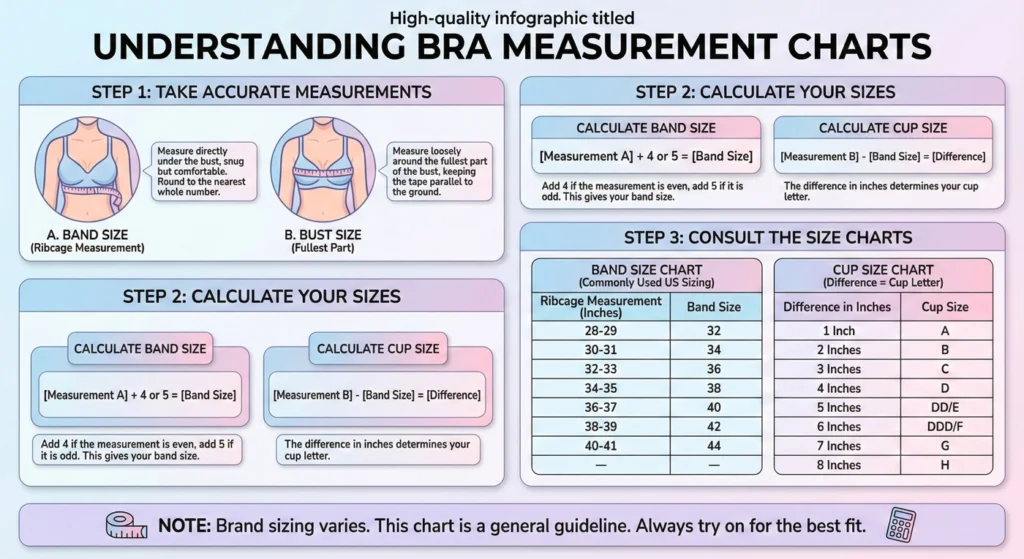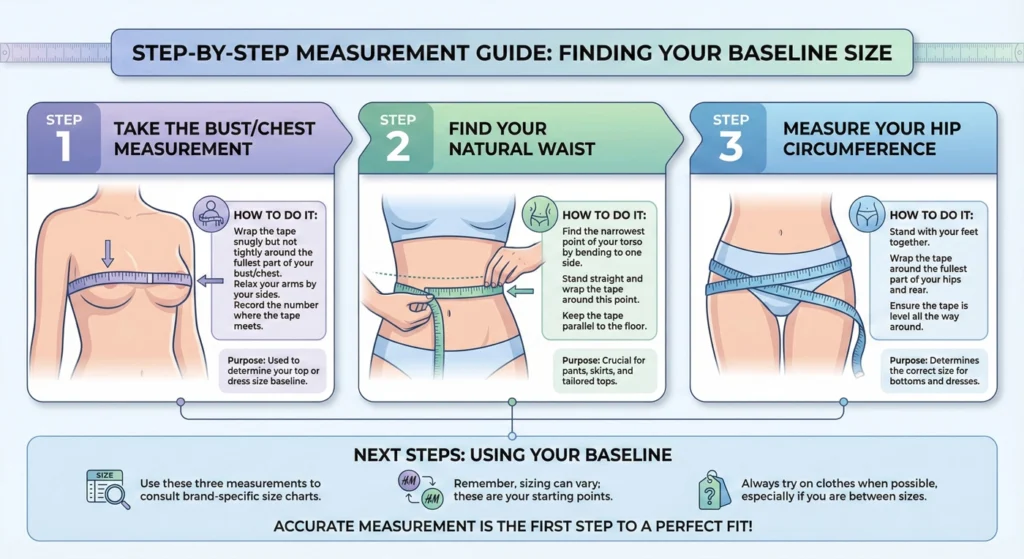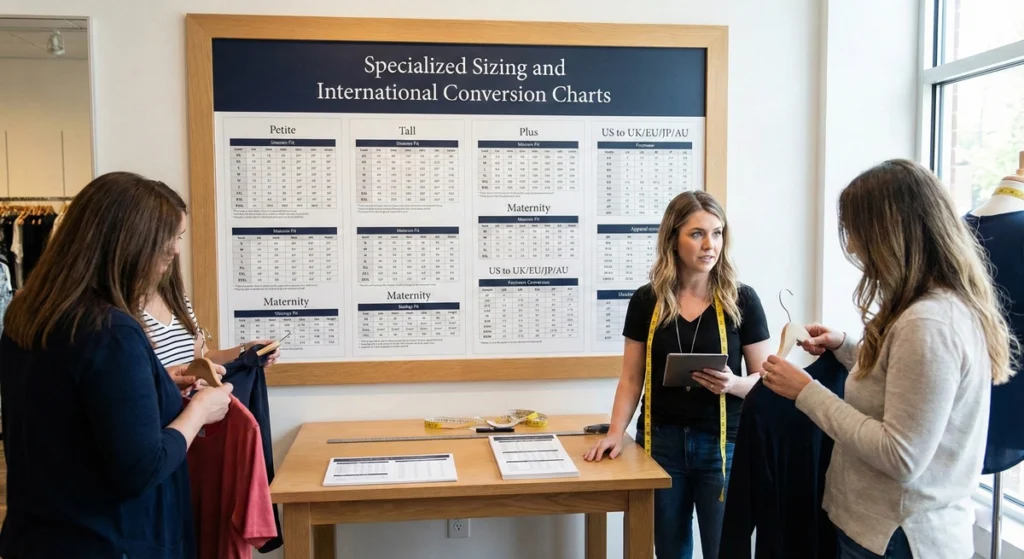Okay, let’s talk about something that affects literally half the population but somehow remains a total mystery: finding the right bra size. Here’s the shocking truth that’ll probably make you do a double-take—studies suggest that up to 80% of women are walking around in the wrong bra size. Yep, you read that right. Eighty percent!
And honestly? It’s not surprising when you think about it. We’re all out here guessing our size based on what we wore five years ago, or grabbing whatever looks cute without actually checking if it fits properly. The result? Uncomfortable underwire digging into your ribs, straps that won’t stay put, back pain that makes you feel like you’re 80 years old, and let’s not even get started on the dreaded quad-boob situation.
But here’s the good news: you don’t have to live like this anymore. This guide is basically your new best friend when it comes to understanding the bra measurement chart and finally—finally—finding bras that actually fit. No more guesswork, no more settling for “close enough,” just comfortable, supportive bras that make you feel amazing. Let’s dive in!
- Bra Sizing Fundamentals: Band, Cup, and the Crucial Ratio
- Step-by-Step Measurement Guide: Finding Your Baseline Size
- Mastering Sister Sizes: The Ultimate Bra Shopping Tool
- The Final Fit Check: Key Indicators of a Perfect Bra
- Specialized Sizing and International Conversion Charts
- Navigating International Sizing Differences
- Specialized Fit Considerations
- Frequently Asked Questions
- How Often Should I Measure Myself for a New Bra?
- What Problems Can Wearing a Wrong or Too Tight Bra Cause?
- How Do I Measure Bra Size If I Don't Have a Tape Measure?
- Does Bra Size Change Based on Breast Shape?
- Conclusion: The Best Bra Size is the One That Fits You
Bra Sizing Fundamentals: Band, Cup, and the Crucial Ratio

Understanding the Two Essential Measurements
Before we get into the how-to measure bra size chart stuff, let’s break down what those numbers and letters actually mean. Because honestly, bra sizing can feel like you’re trying to decode some secret language.
Band Size (The Number): This is the number part of your bra size—like the 34 in 34D. It’s the measurement around your ribcage, right under your bust. And here’s something most people don’t know: the band provides about 80% of your bra’s support. Not the straps—the band! Mind-blowing, right? In the US, band sizes are typically even numbers ranging from 28 all the way up to 56, so there’s definitely something for everyone.
Cup Size (The Letter): This is the letter part—A, B, C, D, and so on. It represents the difference between your bust measurement and your band measurement. The bigger the difference, the larger the cup size. Pretty straightforward once you know the secret!
The Critical Concept of Proportional Volume
Now here’s where it gets a little wild, and this is something that trips up basically everyone: cup volume is relative to the band size. Translation? A 34D doesn’t hold the same amount of breast tissue as a 38D. The cup size only makes sense in relation to the band it’s paired with. This is fundamental to how bras are engineered, and understanding this will completely change your shopping game.
Fun fact time! Did you know that women have been trying to wrangle their breasts into submission for centuries? We went from super restrictive corsets in the late 1800s to the first modern bra in 1914 (thank you, Mary Phelps Jacob!), and cup sizes weren’t even introduced until the 1930s. We’ve come a long way, friends.
Step-by-Step Measurement Guide: Finding Your Baseline Size

Alright, let’s get down to business. Grab yourself a soft measuring tape—you know, the flexible fabric kind that tailors use. Don’t have one? No worries! You can totally use a piece of non-stretchy string or ribbon and then measure it with a regular ruler. MacGyver would be proud.
Quick prep note: You’ll want to measure yourself while standing up, either in an unpadded bra or no bra at all. And pro tip? Remeasure yourself at least once a year because bodies change, and that’s totally normal!
Step 1: Accurate Band Measurement (Underbust)
First things first: wrap that measuring tape snugly around your ribcage, right under your bust. Make sure it’s parallel to the floor—not riding up your back like it’s trying to escape. You want it snug but not so tight that you can’t breathe.
The calculation part: Round your measurement up to the nearest even number. So if you measure 35 inches, you’re a 36. If you’re at 39 inches, round up to 40. Easy peasy!
Step 2: Accurate Bust Measurement (Overbust)
Now measure around the fullest part of your bust. This is usually right across your nipples, but everyone’s different.
Advanced tip that professional fitters swear by: Bend forward at the waist so your chest is parallel to the ground when you measure. I know, I know, it feels weird, but this technique actually ensures you’re measuring the fullest part of your bust, especially if you’ve got pendulous breasts. Trust the process!
Step 3: Calculating Cup Size from the Difference
Time for some simple math! Subtract your band measurement (from Step 1) from your bust measurement (from Step 2). The difference tells you your cup size.
Here’s the standard US bra measurement chart us conversion:
- 1 inch difference = A cup
- 2 inches = B cup
- 3 inches = C cup
- 4 inches = D cup
- 5 inches = DD or E cup
- 6 inches = DDD or F cup
- 7 inches = G cup
- 8 inches = H cup
And it keeps going! The standard largest US cup size is N cup, with sizes ranging from AAA (yes, that exists!) all the way to N. There’s a size for everybody.
Warning Against the “+4 Method”
Okay, public service announcement: if anyone tells you to add 4 inches to your underbust measurement to get your band size, RUN. Seriously, this is called the “+4 method” and it’s super outdated. Modern bra fitting suggests using your actual underbust measurement (rounded to the nearest even number) instead. The old method leaves you with a band that’s way too loose, which means you’re getting terrible support and probably adjusting your bra every five minutes. Nobody’s got time for that.
Mastering Sister Sizes: The Ultimate Bra Shopping Tool

Definition of Sister Sizes
Alright, now we’re getting into the really cool stuff. Sister sizes are about to become your new secret weapon when you’re shopping for bras.
So what are they? A sister size is a bra that has the same cup volume as your usual size but uses a different band and cup combination. It’s like magic, but it’s actually just clever math.
The rule is simple: If you go up one band size, you go down one cup size. And vice versa! For example, if you normally wear a 34D, your sister sizes are 32DD (smaller band, bigger cup) and 36C (bigger band, smaller cup). All three of these sizes have essentially the same cup volume, just distributed differently.
When Sister Sizing Becomes Essential
Sister sizing isn’t just some fun trivia—it’s actually super practical. Here’s when you’ll want to use it:
Your exact size is sold out. We’ve all been there. You find the perfect bra, but they don’t have your size. Sister sizes to the rescue!
You’re between band sizes. Maybe a 34 feels a smidge too tight but a 36 is too loose. Try a 36 with a smaller cup (sister size) and adjust the band tighter with the hooks.
Brand variations are driving you nuts. Some brands run small, some run large. If a particular brand’s 34 band feels too snug, try the 36 sister size instead.
Troubleshooting quick guide: If your band fits perfectly but the cups are wrong, just change the cup size—stick with your band. But if the band is the problem (too tight or too loose), then use sister sizing to adjust both the band AND the cup to maintain that cup volume.
The Final Fit Check: Key Indicators of a Perfect Bra
You’ve measured, you’ve calculated, you’ve tried on a bra. Now what? Here’s how to tell if it actually fits.
Band Fit Checklist (80% of Support)
Remember, the band is doing most of the heavy lifting here—literally!
The snug test: Your band should fit snugly on the loosest hook when the bra is brand new. Why the loosest hook? Because as your bra stretches out over time (and it will), you can tighten it using the middle and tightest hooks. You’re basically future-proofing your bra.
The finger test: You should be able to fit only one or two fingers underneath the band. If you can fit your whole hand under there, the band’s too big. Tighten it up!
The level check: The band should sit level all the way around—same height in the front and back. If it’s riding up your back, it’s too loose and not giving you proper support.
Big warning sign: A band that’s too loose won’t provide the support you need, no matter how great everything else feels. Don’t ignore a loose band!
Cup Fit Checklist (Full Encapsulation)
Your cups should be like a comfy hug for your breasts—not too tight, not too loose.
No spillage, no gapping: The cups must fully contain all your breast tissue. No “quad-boob” situation where tissue is spilling out the top, and no gapping where there’s empty space in the cup. Both are signs of a poor fit.
The gore test: That little piece between the cups (called the center gore) should lie flat against your sternum. If it’s floating out in space, your cups are too small. If it’s digging in painfully, something’s off with the fit.
Strap and Underwire Check
Straps: They should sit comfortably on your shoulders without digging in or sliding off. Here’s the thing though—straps are mainly there to keep your breasts positioned correctly, not to carry all the weight. If your straps are doing all the work, your band is probably too loose!
Underwire: If your bra has underwire, it should follow the natural crease under your breast without sitting on any breast tissue. And it definitely shouldn’t be stabbing you in the armpit. If it is, you might need a different size or a different style altogether.
Specialized Sizing and International Conversion Charts

Navigating International Sizing Differences
Here’s something that’ll blow your mind if you’ve never shopped for bras internationally: bra sizing is not standardized across countries. At all. It’s kind of a mess, honestly.
European sizing: Uses centimeters instead of inches, and they don’t use double letters like DD. Their cup progression goes A, B, C, D, E, F, G. So a US DD is a European E cup. Confusing? Yep.
UK sizing: Similar to US sizing but diverges after D cup. A US DD is a UK E, and a US G is a UK F. Why? Who knows! But it’s important to know when you’re ordering that cute British bra online.
Australian and New Zealand sizing: These folks use a completely different number system for bands. Their sizes start at 8 and go up by 2s. An Australian 8 equals a US 30 band. You basically need a decoder ring.
Specialized Fit Considerations
Plus size bras: Extended band sizes (usually 38 and up) often feature modified cup progressions specifically designed for fuller figures. The engineering is different because the support needs are different. Don’t feel limited—there are SO many gorgeous options out there now!
Maternity and nursing bras: If you’re pregnant or breastfeeding, your size is gonna fluctuate like crazy. It’s wild. Most experts recommend measuring yourself around 8 months pregnant or about 2-3 weeks postpartum to get a baseline. And honestly? You might want to get measured again a few months into breastfeeding because things can change a lot.
Sports bras: These can be tricky because some use compression sizing (S, M, L, XL) while others use the traditional number-letter system. Either way, you usually want a snugger band for sports bras, especially for high-impact activities like running. No one wants to give themselves a black eye while jogging!
Frequently Asked Questions
How Often Should I Measure Myself for a New Bra?
Real talk? You should be remeasuring at least once a year. I know, I know, that sounds like a lot. But hear me out—your body changes! Weight fluctuations of just 5+ pounds can affect your bra size. Hormonal changes, pregnancy, breastfeeding, menopause, even just aging can all shift things around. So yeah, make it an annual thing. Maybe do it on your birthday? Make it a whole self-care ritual.
What Problems Can Wearing a Wrong or Too Tight Bra Cause?
Okay, this is actually important. Wearing an ill-fitting bra isn’t just uncomfortable—it can cause real problems. We’re talking breast pain, back pain (especially lower back), neck and shoulder pain (hello, tension headaches!), chafing and skin abrasions, rib pain, and even premature sagging because your breasts aren’t getting proper support.
If you’ve got larger breasts, wearing the wrong size can make all these issues even worse. Your body is literally working overtime to compensate for poor support. So yeah, it’s worth taking the time to get fitted properly!
How Do I Measure Bra Size If I Don’t Have a Tape Measure?
Been there! No measuring tape? No problem. Grab a piece of string or non-stretchy ribbon and wrap it around yourself for both the band and bust measurements. Mark where the string meets itself (a marker or even just pinch it with your fingers and have someone help). Then lay that string flat and measure the length with a regular ruler or even a yardstick. It’s not fancy, but it absolutely works.
Does Bra Size Change Based on Breast Shape?
Great question! So here’s the thing: while your measurements give you a starting point size, breast shape totally matters when it comes to which style of bra will actually fit you well. Two women could both measure as a 34C, but if one has wide-set breasts and the other has projected breasts, they’re going to need different bra styles to get a good fit.
Breast shape factors include how far apart they are, how much projection they have, how firm or soft the tissue is, whether they’re more full on top or bottom—it’s a whole thing. This is why you might find one brand’s 34C fits perfectly while another brand’s 34C in the same style is terrible. The measurements are the foundation, but shape determines which specific bras will work for you.
Conclusion: The Best Bra Size is the One That Fits You
Look, finding your perfect bra fit is part science, part art, and part just listening to your body. You need accurate measurements (check!), knowledge of sister sizes (you’re now an expert!), an understanding that brands can vary wildly (seriously, try before you buy when possible), and most importantly, you need to trust your own comfort.
At the end of the day, the letter and number on that tag matter way less than how the bra actually feels when you’re wearing it. Does it support you? Can you move freely? Are you adjusting it constantly or does it just… work? That’s what matters.
If you’re still feeling overwhelmed or just want some extra confidence in your size, there are tons of specialized bra size calculator tools online that can help. Or honestly? Book a professional fitting at a good lingerie store. They’ve seen it all, they won’t judge you, and they can be absolute lifesavers when you’re struggling to figure out your size.
You deserve bras that fit properly and make you feel comfortable and confident all day long. So take your measurements, use this bra measurement chart guide, and go forth into the world of properly fitting bras. Your back, your shoulders, and your breasts will thank you. Trust me on this one!